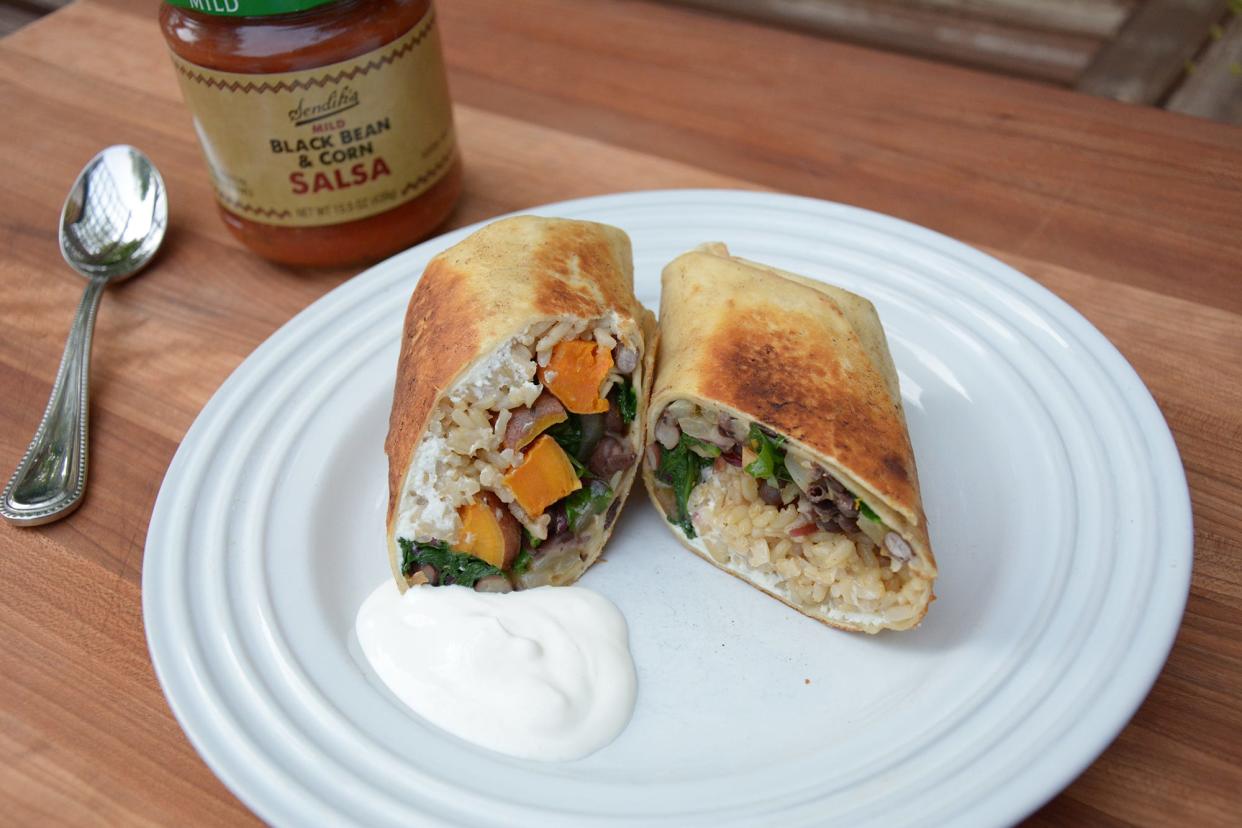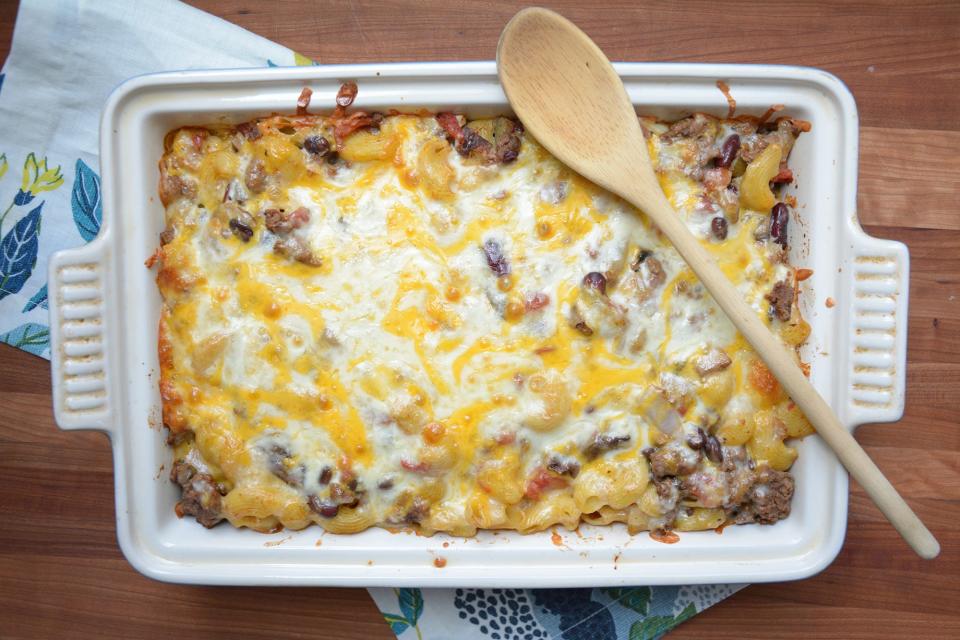Here's how to eat without spending a fortune on groceries

If your recent trip to the grocery store seems like it cost more than it used to, it’s not in your head.
Grocery costs are 7.9% higher than they were a year ago, according to the Consumer Price Index. And with the U.S. Department of Agriculture predicting prices will rise another 3% to 4% by the end of the year, this problem doesn’t show signs of going away anytime soon.
But local shoppers are finding strategies to cope, watching their costs with such tactics as "shopping" their own freezer and buying less-traveled local produce.
The grocery dilemma
Some of the biggest price increases are for meat, fish, poultry and eggs, said James McGibany, chairman of the economics department at Marquette University. But why this is happening and what the consequences will be are complicated issues.
“Where a lot of this is coming from is oil and energy,” he says. “A lot of it spills over into other things, especially food.”
Take energy. He says that unless someone is living in California or Florida, consumers are getting a lot of their food shipped to them. Because of how far food has to travel, when the price of energy and gas goes up, so does the price of food.
“Another issue is how the Russian embargos will affect things,” McGibany says. Because Ukraine and Russia house big fertilizer companies, that will affect other things, such as the price of feed for livestock.
“The war hasn’t hit anything yet, but the first thing you’ll probably see is the feed costs for animals will go up. And what may have been used for feed will be used for people.”
The recent bird flu outbreak has affected the prices of chicken and eggs. And we’re still seeing supply chain issues and a labor shortage, especially for truck drivers and production workers, further exacerbating to the problem.
“There are so many things going on at once that it’s hard to isolate,” McGibany says. “Inflation is going up in areas that are staples we can’t avoid. Are we going to avoid paying for other things, and will that slow the economy down?”

The effect on grocery stores
Outpost Natural Foods has seen noticeable price increases for over a year, said Margaret Mittelstadt, director of community relations.
“What we’re seeing in store is across departments. We don’t have one area that’s rising faster than others,” she says. “We are having supply chain issues with nonperishable food items and transportation issues that are affecting this, too. Because of this, customers may see some holes in the shelves.”
One silver lining for people concerned about higher prices is that the growing season is starting.
“We’ll see a lot of local produce come in as the growing season progresses,” said] Mittelstadt. “These types of items are going to be more competitively priced because they aren’t coming from around the globe.”
There are health benefits from shopping this way, too. Local produce is more nutrient-dense because everything is harvested at the peak of ripeness, and it doesn’t have to travel far to get to consumers (meaning the food loses less of its nutrients en route).
“If there’s anything you can do during these hard times, support local. From farmers markets to community supported agriculture, it helps with jobs, too,” Mittelstadt said.
Another secret to save money is shopping the bulk department. Outpost has over 100 items in its bulk department, including flour, beans, sugar and spices. Buying the exact amount of what you need — two cups of whole wheat flour vs. buying the entire five-pound bag — will save you money because you aren’t paying for the excess.

Planning ahead is everything
Philia Kelnhofer, a Greenfield resident and mother of four under age 4½, has preached the benefits of easy recipes through her blog Sweetphi and cookbook “Fast and Easy Five-Ingredient Recipes: A Cookbook for Busy People” (The Countryman Press, 2016, $21.95).
“When you’re talking about prices going up and you’re looking at a recipe with 20 ingredients, 10 of which you’ll only use once, or a recipe with five ingredients that you’ll use all the time,” she said, “I would opt for easier recipes because you won’t have these random things left over in your pantry.”
“Don’t underestimate simple dishes with fewer ingredients,” she says. “Once or twice a week, we’ll have rice bowls with whatever leftover toppings we have.”
For her sushi rice bowls, Kelnhofer combines brown rice with a sauce (such as mayonnaise and a pre-made chili garlic sauce) with canned salmon or tuna, cucumber and avocado.
“It’s so cheap,” she says.
To feed her family of six as economically as possible, she also meal plans and shops her own pantry and freezer before heading to the grocery store.
“As a mom, I have all these fruits, vegetables and meat that I always put in the freezer,” Kelnhofer said. “So when I shop, my grocery list is shorter.”
“I also look to see what I have first. So if it’s a can of black beans, then I’ll make something with rice, something Mexican or black bean burgers.”

Marian Topp of Whitefish Bay echoes that sentiment. “I shop the perimeter of the store and stick to my shopping list,” she said of her grocery store habits, along with downloading digital coupons on her Pick ‘N Save loyalty card.
“I didn’t always do this. I always used the coupons they would send me (in the mail), but I used to buy whatever I wanted and did a lot of spur-of-the-moment shopping and get things that weren’t on my grocery list.
"I used to go to the grocery store three or four times a week,” Topp says. “Now I go maybe once, and I clean our my freezer before I go.”
Shorewood resident Apinya Jordan has also noticed the prices going up “on everything” at the Asian grocery stores where she shops. Where flour used to be 99 cents, she now sees it for $2.59. To combat this, she started having her husband do a lot of the grocery shopping.
“I don’t want to witness it. I try to avoid it. It doesn’t bother my husband,” she said. “For him, it’s a responsibility to the family that you have to get what you’ve got to get. It’s something you can’t avoid because you have to feed those mouths.”
If Jordan does go to the grocery store, she’ll only get what’s on her shopping list. “I stick to what I need and don’t browse,” she said. “I’m more conscious about what I buy.”
Alysha Witwicki is a freelance writer living in Whitefish Bay. Contact her at alyshawitwicki@hotmail.com
*****
10 ways to cut your grocery bill
Concerned about the rising cost of groceries? Here are 10 things you can do, according to James McGibany, Margaret Mittelstadt and Philia Kelnhofer.
1. Shop what’s on sale. Look at the printed or digital store ads before making your grocery list.
2. Stick to less-expensive grocery stores, such as Aldi and Walmart.
3. Don’t buy the most premium cut of meat. For example, buy chicken thighs instead of chicken breasts.
4. Eat less meat and go meatless as much as you can.
5. Stay connected. Sign up for your favorite grocery stores’ newsletters and emails to stay in the know about sales and recipe inspiration.
6. Re-examine your habits around meal planning and food. Even with prices going up, food waste is a huge issue in America. Plan ahead to stay organized and create less waste.
7. Buy produce when it’s in season, and preserve extras through pickling and canning. For a resource on what’s in season when, check out Outpost Natural Foods' guide at bit.ly/3MM55br.
8. Make more from scratch. Homemade food is often cheaper and less processed than pre-made convenience foods — for example, pasta salad that you buy at the deli.
9. Freeze as much as you can. Whether it’s that last serving or two of lasagna that you’re sick of eating or bagged spinach that you won’t use up before vacation, throw it all in the freezer to eat later. For that spinach or other fruits and vegetables, throw it in a smoothie (you can also do this with apples, cucumbers, bananas and more).
10. Start gardening. Vegetable seeds are cheap. Start growing your own food for the ultimate saver in cost.
*****
RECIPES
This recipe is from Greenfield blogger Philia Kelnhofer. You can find it at sweetphi.com. If your store has them, add fried plantains on the side for an extra Caribbean flair.

5-ingredient jerk chicken and rice bowls
Recipe tested by Alysha Witwicki
Makes 4 servings
1 cup Jamaican jerk marinade
1 pound boneless skinless chicken breasts (about 2 large breasts)
1 pound stir-fry vegetables, such as broccoli, shredded carrots, peppers, onions and cabbage (fresh or frozen)
2 8.5-ounce packages Uncle Ben's Ready Rice
¼ cup coconut milk (optional)
Pour Jamaican jerk marinade over chicken and let marinate for a minimum of 1 hour, but overnight is even better.
In a frying pan over high heat, sauté chicken for 5 minutes. Flip and cook for another 5 minutes. Add in stir-fry vegetables and ½ cup water. Put lid on pan and sauté for 6 minutes.
While vegetables are cooking, make instant rice in microwave. If using coconut milk, pour rice into a bowl and pour coconut milk over rice, stir to combine.
Slice/divide chicken breasts, vegetables and rice into 4 bowls and enjoy.
*****
This recipe is adapted from the Winter 2016 issue of Graze, Outpost Natural Foods’s quarterly magazine. You can find all back issues on their website, outpost.coop.
Black bean, sweet potato and greens burrito
Recipe tested by Alysha Witwicki
Makes 4 servings
1½ tablespoons olive oil, plus more if needed
½ cup diced onions
2 cloves garlic
1 teaspoon ground cumin
½ teaspoon oregano
½ to 1 teaspoon chili powder, or to taste
2 cups canned black beans, rinsed and drained
Salt and pepper to taste
4 large tortillas
4 ounces goat cheese, divided
1 cup roasted sweet potatoes, warmed and divided
1 cup frozen corn, thawed, warmed and divided
1½ cups rice, cooked according to package directions, divided
2 cups sauteed greens, such as kale, chard, spinach or collards, divided
Sour cream and salsa for garnish
In a frying pan over medium heat, add oil, onions, garlic, cumin, oregano and chili powder; cook until the onions are translucent, about 5 minutes. Add black beans, mix well, and cook until just warmed through. Season to taste with salt and pepper. Remove mixture from pan and place in a bowl.
To assemble, take one large tortilla and spread one-fourth of the goat cheese on top. Next, add one-fourth of the sweet potatoes, corn, rice, bean and onion mixture and sauteed greens. Wrap up like a burrito and cook over medium heat for 3-4 minutes (adding a little bit of olive oil as necessary).
Flip and cook for another 3 minutes, or until golden brown on both sides. Serve with salsa and sour cream.
*****
This budget-friendly dish from Taste of Home is like chili in casserole form. A bonus is that it makes two casseroles, one to eat now, and one to freeze for later.

Southwestern casserole
Recipe tested by Alysha Witwicki
Makes 2 casseroles, 6 servings each
2 cups (8 ounces) uncooked elbow macaroni
2 pounds ground beef
1 large onion, chopped
4 garlic cloves, minced
2 cans (14½ ounces each) diced tomatoes, undrained
1 can (16 ounces) kidney beans, rinsed and drained
1 can (6 ounces) tomato paste
1 can (4 ounces) chopped green chiles
½ teaspoon salt
1 teaspoon chili powder
½ teaspoon ground cumin
½ teaspoon pepper
2 cups shredded Monterey Jack cheese
2 jalapeno peppers, seeded and chopped
Cook macaroni according to package directions. Meanwhile, in a large saucepan, cook beef and onion over medium heat, crumbling beef, until meat is no longer pink. Add garlic; cook 1 minute longer. Drain.
Stir in next 8 ingredients. Bring to a boil. Reduce heat; simmer, uncovered, for 10 minutes. Drain macaroni; stir into beef mixture.
Heat oven to 375 degrees. Transfer macaroni mixture to two greased 2-quart baking dishes. Top with cheese and jalapenos. Cover and bake at 375 degrees for 30 minutes. Uncover; bake until bubbly and heated through, about 10 minutes longer.
Serve 1 casserole. Cool the second; cover and freeze up to 3 months.
To use the frozen casserole, thaw in refrigerator for 8 hours. Preheat oven to 375°. Remove from refrigerator 30 minutes before baking. Cover and bake, increasing time as necessary to heat through and for a thermometer inserted in center to read 165 degrees, 20-25 minutes.
Sign up for our Dish newsletter to get food and dining news delivered to your inbox.
Our subscribers make this reporting possible. Please consider supporting local journalism by subscribing to the Journal Sentinel at jsonline.com/deal.
DOWNLOAD THE APP: Get the latest news, sports and more
This article originally appeared on Milwaukee Journal Sentinel: How to eat without spending a fortune on groceries

